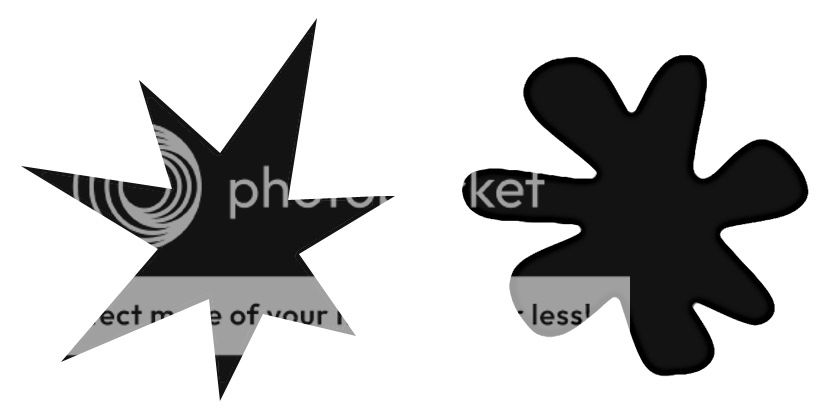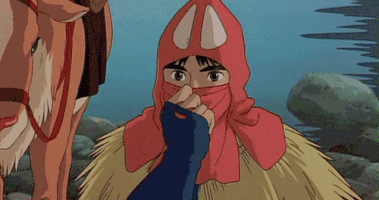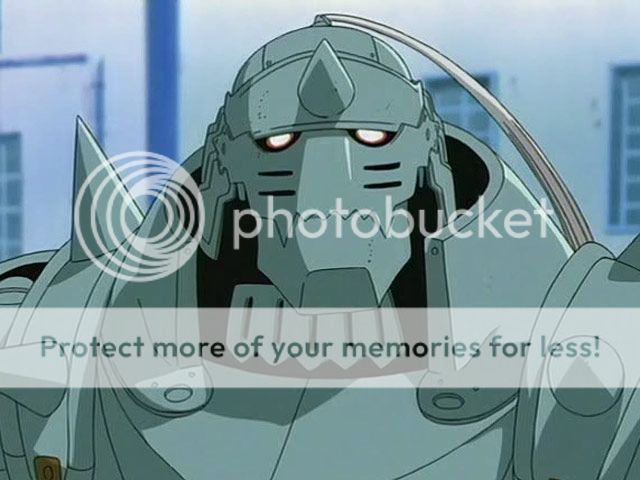Kiki, or Bouba? Synesthesia Theory in Anime
Take a good look at these two shapes:
What do you see? What makes them unique? What makes them stick out? What if I told you one of them is called “Kiki” and the other “Bouba”? If I were to ask which was which without giving any clues, do you think you could point them out? According to Synesthesia Theory, first coined by German-American psychologist Wolfgang Köhler in 1929, upwards of 90% of those asked about Kiki and Bouba would respond the same way without much thought: the sharp, pointed blob would be identified as Kiki, while the rounded, softer blob would be identified as Bouba. That this is universally-accepted even by the uneducated shows how similar language structures really are.
I first heard about Kiki and Bouba in this video. The video dealt with geometry in film, and how it can subtly influence how we perceive the medium. The narrator began with the above question, then went on to explain how said concepts worked. The part that stuck with me most on a personal level was how he mentioned “Kiki VS Bouba” in relation to animation, and how it plays around with both shapes. I then began to think about its relationship to anime, particularly in how it uses both to influence its viewers.
Now, remember that Kiki and Bouba, like The Bechdel Test, aren’t an exact science. Art doesn’t exist in a vacuum, nor is it objective. Anime, which has seen a gradual shift in the last 20 or so years, is doubly-so, as most modern-day anime, and even some early anime, uses Bouba-esque designs. That said, if I applied Synesthesia Theory to anime, movie and show-alike, would it hold up?
I’ll start with film, since it’s usually given bigger budgets than shows and, therefore, has more of a stylistic identity. Most films have protagonists with soft, rounded faces and eyes, and sometimes mouths and noses. This is because we’re meant to relate to them. A character like Ashitaka, who’s clearly the audience-insert, has an oval-like head and rounded eyes, not to mention a flat-cut haircut, rounded shoulders and stubby feet underneath his shoes. His hood and mask might be slightly pointy, but even then there’s a softness to both. He’s incredibly Bouba, so much so that it’s hard to take him seriously when he’s angry, which happens quite a bit.
On the flip-side, we have Lady Eboshi, who’s the “unofficial-official” antagonist of Princess Mononoke. Lady Eboshi’s interesting in that the lower-half of her body is Kiki in shape: she’s got slender hands, baggy pants and even wears a cloak that looks triangular. She also to has a hat that’s pointy on both ends, and her hair is tied in a pointed ponytail. That she tends to slant her eyebrows upwards creates a diagonal line to her adjacent eyes. However, her head is round and soft, much like Ashitaka’s. Her body and hair might be Kiki, but her face is undeniably Bouba. This contrast subtly reinforces the ambiguity of her character-is she a villainess, or a heroine?
If you want polar extremes with Miyazaki movies, look no further than Chihiro Ogino and Yubaba from Spirited Away. Chihiro’s face screams “moe”, something I discussed last time, and it makes sense: her nose is almost non-existent, she has a round head, her eyes are ovular and she has flush cheeks. She’s cute, but she’s also a Bouba character. Even her name sounds soft, both before and after it’s changed, furthering the cuteness and relatable nature of her personality. Like Ashitaka, she’s the audience-insert, and her design reflects that.
Yubaba, on the other hand, is a Kiki character. She looks ugly, but her most-discernibly Kiki characteristic is her hooked nose. The nose is triangular, a typical Kiki trait. Additionally Kiki elements are her long, pointy fingernails and that her bird-form is triangular. Again, like Lady Eboshi, Miyazaki is sending subtle reinforcements about how we’re to view Yubaba. Except that, unlike Lady Eboshi, we’re supposed to be disgusted.
The idea of Kiki and Bouba can also be applied to non-villainous characters. In The Wolf Children, Yuki and Ame, particularly during early childhood, are Bouba characters, especially in their wolf forms. Their father, on the other hand, is more Kiki as both a human and a wolf, hence his somewhat intimidating appearance initially. These subtleties reflect a sense of maturity versus immaturity, denoting how we view kids and adults differently. It’s not overt, unlike Yubaba in Spirited Away, but the demarcations are there and, thus, understood in unique ways.
But why stop there? The title character in Millennium Actress, Chiyoko Fujiwara, has two stages of her life presented in the film. The first is the old woman stage, where she recounts her story to a journalist, while the second is flashbacks to her younger days as an actress. The film is clever and definitely worth a watch, but one element that sticks out is the designs on the faces of both Chiyokos: young Chiyoko, for instance, has soft, rounded features, a distinctly Bouba archetype. Conversely, old Chiyoko has saggy, elderly features that denote age, falling more in-line with Kiki. This progression is natural, especially given the age difference, but it also denotes that Kiki and Bouba aren’t inherently black-or-white. If anything, they can highlight the differences between youth and experience.
And this doesn’t even have to be drastic. Taeko from Only Yesterday is a 27 year-old woman who reminisces about her 10 year-old self growing up in Tokyo, and the differences in art styles and designs shine through: young Taeko is soft and pale, even cherub-like in appearance, while older Taeko looks more adult and has noticeable dimples. The latter initially bothered me, and it still does to an extent, but applying Kiki and Bouba makes them easier to digest: young Taeko is Bouba, older Taeko is Kiki. Neither are drastic, the latter still has Bouba features, but it’s enough to understand the age difference without it being spelled out.
I’ve talked a lot about anime films, so what of shows? The differences exist there too, but they’re harder to notice. The whole moe trend is meant to “Bouba-ize” anime characters, perhaps a little too much, but it does occasionally work to the show’s advantage when it’s used to comment on something specific (see every character model in Mahou Shoujo Puella Magi Madoka Magica.) However, even in less “moe-ified” anime, the distinctions are still there: Edward Elric from the Fullmetal Alchemist franchise is a Bouba character, something additionally played up for laughs via his height. The four leads in Wolf’s Rain, especially Toboe, have Bouba-like faces, obviously by way of attachment. But then you have characters from that same show, i.e. the nobles, who have harsher features, aka Kiki. Lord Darcia is especially Kiki whenever he puts on his mask, which is littered with points and rugged feathers.
Of course, we also have the kids from the Digimon franchise, all of whom are Bouba to the point where you’d be in denial to not notice.
So what about when Kiki and Bouba are flipped to create a jarring reaction? Well, a perfect example is Alphonse Elric in the Fullmetal Alchemist series. In his human form there’s no denying that he’s a Bouba character, but after his soul is transferred to a suit of armour he's more Kiki. And yet, we’re supposed to relate to him. Still, his appearance is quite unsettling, enough that both shows resort to Manga Iconography to make him feel Bouba enough in times of levity and humour.
Overall, these uses of Kiki and Bouba, as with anything else, help convey meaning in ways fans aren’t fully-aware of. Whether it’s via denoting protagonist and antagonist, mixing them up to create conflict, using them in the same characters to create perspective, or flipping expectations to challenge the viewers, these shapes and concepts are everywhere. And yes, like I said earlier, this isn’t exact science. Synesthesia Theory isn’t absolute, it’s merely a rough guideline for visual language. But it’s worth noting the next time you watch anime.
(Also, despite her name, Kiki from Kiki’s Delivery Service is a Bouba character. Sorry internet, there’s no Illuminati!)
What do you see? What makes them unique? What makes them stick out? What if I told you one of them is called “Kiki” and the other “Bouba”? If I were to ask which was which without giving any clues, do you think you could point them out? According to Synesthesia Theory, first coined by German-American psychologist Wolfgang Köhler in 1929, upwards of 90% of those asked about Kiki and Bouba would respond the same way without much thought: the sharp, pointed blob would be identified as Kiki, while the rounded, softer blob would be identified as Bouba. That this is universally-accepted even by the uneducated shows how similar language structures really are.
I first heard about Kiki and Bouba in this video. The video dealt with geometry in film, and how it can subtly influence how we perceive the medium. The narrator began with the above question, then went on to explain how said concepts worked. The part that stuck with me most on a personal level was how he mentioned “Kiki VS Bouba” in relation to animation, and how it plays around with both shapes. I then began to think about its relationship to anime, particularly in how it uses both to influence its viewers.
Now, remember that Kiki and Bouba, like The Bechdel Test, aren’t an exact science. Art doesn’t exist in a vacuum, nor is it objective. Anime, which has seen a gradual shift in the last 20 or so years, is doubly-so, as most modern-day anime, and even some early anime, uses Bouba-esque designs. That said, if I applied Synesthesia Theory to anime, movie and show-alike, would it hold up?
I’ll start with film, since it’s usually given bigger budgets than shows and, therefore, has more of a stylistic identity. Most films have protagonists with soft, rounded faces and eyes, and sometimes mouths and noses. This is because we’re meant to relate to them. A character like Ashitaka, who’s clearly the audience-insert, has an oval-like head and rounded eyes, not to mention a flat-cut haircut, rounded shoulders and stubby feet underneath his shoes. His hood and mask might be slightly pointy, but even then there’s a softness to both. He’s incredibly Bouba, so much so that it’s hard to take him seriously when he’s angry, which happens quite a bit.
On the flip-side, we have Lady Eboshi, who’s the “unofficial-official” antagonist of Princess Mononoke. Lady Eboshi’s interesting in that the lower-half of her body is Kiki in shape: she’s got slender hands, baggy pants and even wears a cloak that looks triangular. She also to has a hat that’s pointy on both ends, and her hair is tied in a pointed ponytail. That she tends to slant her eyebrows upwards creates a diagonal line to her adjacent eyes. However, her head is round and soft, much like Ashitaka’s. Her body and hair might be Kiki, but her face is undeniably Bouba. This contrast subtly reinforces the ambiguity of her character-is she a villainess, or a heroine?
If you want polar extremes with Miyazaki movies, look no further than Chihiro Ogino and Yubaba from Spirited Away. Chihiro’s face screams “moe”, something I discussed last time, and it makes sense: her nose is almost non-existent, she has a round head, her eyes are ovular and she has flush cheeks. She’s cute, but she’s also a Bouba character. Even her name sounds soft, both before and after it’s changed, furthering the cuteness and relatable nature of her personality. Like Ashitaka, she’s the audience-insert, and her design reflects that.
Yubaba, on the other hand, is a Kiki character. She looks ugly, but her most-discernibly Kiki characteristic is her hooked nose. The nose is triangular, a typical Kiki trait. Additionally Kiki elements are her long, pointy fingernails and that her bird-form is triangular. Again, like Lady Eboshi, Miyazaki is sending subtle reinforcements about how we’re to view Yubaba. Except that, unlike Lady Eboshi, we’re supposed to be disgusted.
The idea of Kiki and Bouba can also be applied to non-villainous characters. In The Wolf Children, Yuki and Ame, particularly during early childhood, are Bouba characters, especially in their wolf forms. Their father, on the other hand, is more Kiki as both a human and a wolf, hence his somewhat intimidating appearance initially. These subtleties reflect a sense of maturity versus immaturity, denoting how we view kids and adults differently. It’s not overt, unlike Yubaba in Spirited Away, but the demarcations are there and, thus, understood in unique ways.
But why stop there? The title character in Millennium Actress, Chiyoko Fujiwara, has two stages of her life presented in the film. The first is the old woman stage, where she recounts her story to a journalist, while the second is flashbacks to her younger days as an actress. The film is clever and definitely worth a watch, but one element that sticks out is the designs on the faces of both Chiyokos: young Chiyoko, for instance, has soft, rounded features, a distinctly Bouba archetype. Conversely, old Chiyoko has saggy, elderly features that denote age, falling more in-line with Kiki. This progression is natural, especially given the age difference, but it also denotes that Kiki and Bouba aren’t inherently black-or-white. If anything, they can highlight the differences between youth and experience.
And this doesn’t even have to be drastic. Taeko from Only Yesterday is a 27 year-old woman who reminisces about her 10 year-old self growing up in Tokyo, and the differences in art styles and designs shine through: young Taeko is soft and pale, even cherub-like in appearance, while older Taeko looks more adult and has noticeable dimples. The latter initially bothered me, and it still does to an extent, but applying Kiki and Bouba makes them easier to digest: young Taeko is Bouba, older Taeko is Kiki. Neither are drastic, the latter still has Bouba features, but it’s enough to understand the age difference without it being spelled out.
I’ve talked a lot about anime films, so what of shows? The differences exist there too, but they’re harder to notice. The whole moe trend is meant to “Bouba-ize” anime characters, perhaps a little too much, but it does occasionally work to the show’s advantage when it’s used to comment on something specific (see every character model in Mahou Shoujo Puella Magi Madoka Magica.) However, even in less “moe-ified” anime, the distinctions are still there: Edward Elric from the Fullmetal Alchemist franchise is a Bouba character, something additionally played up for laughs via his height. The four leads in Wolf’s Rain, especially Toboe, have Bouba-like faces, obviously by way of attachment. But then you have characters from that same show, i.e. the nobles, who have harsher features, aka Kiki. Lord Darcia is especially Kiki whenever he puts on his mask, which is littered with points and rugged feathers.
Of course, we also have the kids from the Digimon franchise, all of whom are Bouba to the point where you’d be in denial to not notice.
So what about when Kiki and Bouba are flipped to create a jarring reaction? Well, a perfect example is Alphonse Elric in the Fullmetal Alchemist series. In his human form there’s no denying that he’s a Bouba character, but after his soul is transferred to a suit of armour he's more Kiki. And yet, we’re supposed to relate to him. Still, his appearance is quite unsettling, enough that both shows resort to Manga Iconography to make him feel Bouba enough in times of levity and humour.
Overall, these uses of Kiki and Bouba, as with anything else, help convey meaning in ways fans aren’t fully-aware of. Whether it’s via denoting protagonist and antagonist, mixing them up to create conflict, using them in the same characters to create perspective, or flipping expectations to challenge the viewers, these shapes and concepts are everywhere. And yes, like I said earlier, this isn’t exact science. Synesthesia Theory isn’t absolute, it’s merely a rough guideline for visual language. But it’s worth noting the next time you watch anime.
(Also, despite her name, Kiki from Kiki’s Delivery Service is a Bouba character. Sorry internet, there’s no Illuminati!)






Comments
Post a Comment